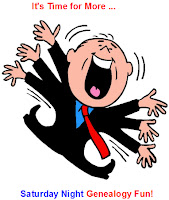I was waiting to see what Randy Seaver posted for this week's Saturday Night Genealogy Fun, but it wasn't a topic that inspired me, so I'm wandering off on my own tonight. I'm thinking about my memories of Christmas, which, like me, are a little eclectic.
One of my earliest memories of Christmas isn't about something expected like Santa Claus. No, it's how when my mother's best friend, Sam, used to come over for Christmas, we would have not only the traditional turkey but also ham, because Sam loved ham. (When Sam was over we also had ham with the turkey for Thanksgiving.) I suspect not many people associate ham with Christmas, but I do. And we usually had sweet potatoes, which my mother tried to convince me once were candy (as in candied yams). It's really hard to trust a parent again when she pulls that on you. By the way, no, I don't like sweet potatoes.
We didn't have a Christmas tree for Christmas; we had a Chanukah bush. Yes, it's the same thing, just with a different name. I don't know why my mother called it a Chanukah bush, since she didn't do anything else Chanukah-ish other than put out a menorah. She didn't light the candles, mind you, just put the menorah out on display. But we had our Chanukah bush to go with the menorah.
One tradition we had whether Sam was visiting us or not was to open one present on Christmas Eve. We had different ways of trying to pick the present: What looked the coolest? Which was the largest? Which had the prettiest wrapping paper? Did one make a certain noise when it was shaken? And my mother was pretty strict that it was only one present, so if you picked a boring one, oh, well! Have to wait until Christma smorning to open the rest! I don't remember any really boring ones, so maybe it always worked out okay.
During the time my family lived in Australia, Boxing Day, the day after Christmas (i.e., December 26), became part of our Christmas routine. I remember that we used to receive an extra gift on Boxing Day, but I don't remember that we gave gifts to any of the people who did work for us during the year. That doesn't mean we didn't, just that I don't remember it.
After moving from home to start college, I flew back and spent the next four Christmases with my parents. What I remember most from those trips is that my mother had gotten hooked on daytime soap operas, and my sister used to watch them with her. I would come, not having seen anything of the shows during the intervening year (because I didn't and still don't watch soap opears), and yet somehow I was able to follow the plots with no problem. That reminds me of an old joke about soap operas: They're the only place where it takes a woman eleven nmonths to have a premature baby.
After I graduated college I didn't have the money to fly back east for Christmas. I started celebrating Christmas locally with friends for the most part, the specifics of which might change from one year to the next depending on where I was living and other factors.
When I was with my ex, I regularly traveled to Portland for the Christmas holidays, because that's where his world was centered. That's when I really started spending Christmas with my "family of choice" (and also had my first white Christmas). And then after we had grandchildren, I went to Portland as much as possible, espcially during Christmas, because the grandchidlren were mostly in that area.
Now that I live in the Portland area myself, I don't have to go as far to see my grandchildren, which is good, because they're now the most important part of my Christmas. This year I visited the three youngest in person on Christmas Eve and had a video chat with the two older ones on Christmas Day and was able to watch them open their presents. And those are great memories to add to the others.
 |
| All five grandchildren, Christmas 2017 |










































